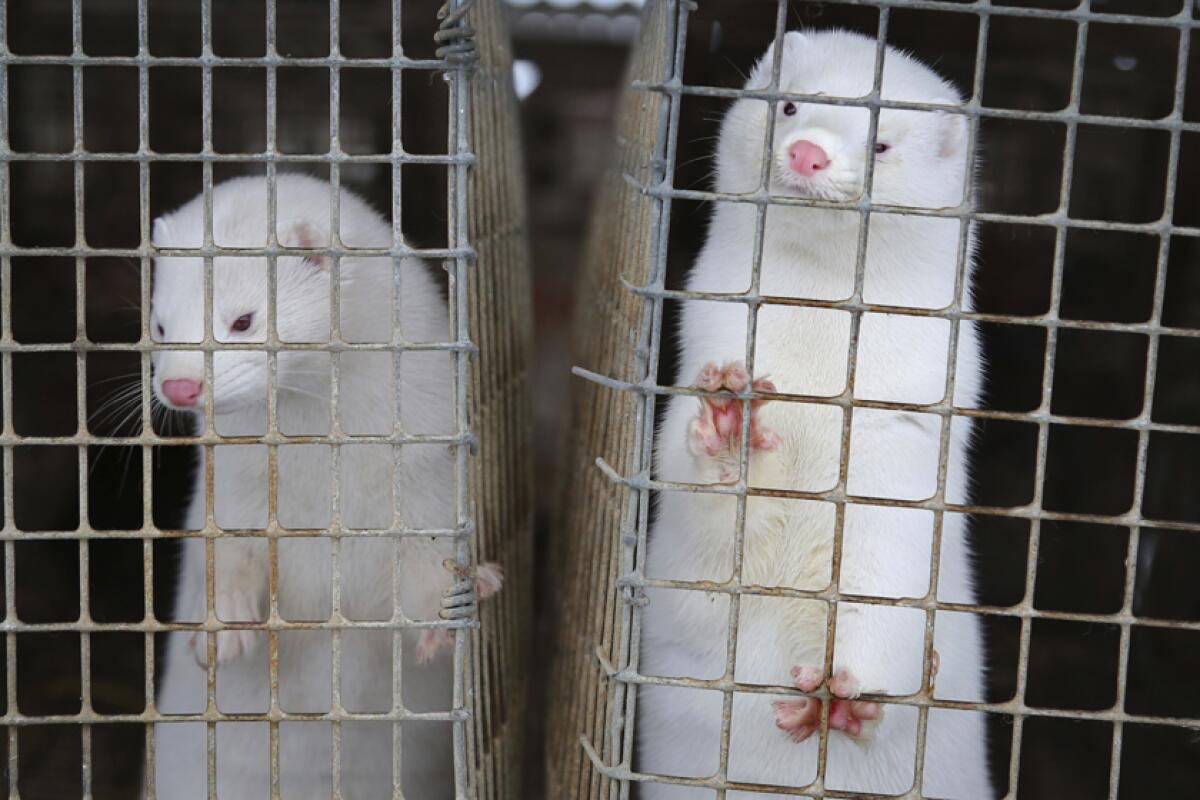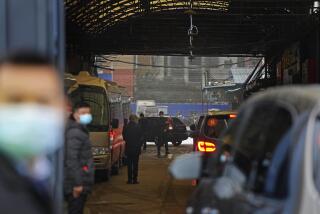Op-Ed: Want to avoid pandemics? Eliminate factory farming

- Share via
You could call it “the silence of the minks.”
In Denmark, all the farmed minks in the country — some 17 million of them — have been destroyed after mutant coronavirus strains were detected in animals on many farms. The disease was able to spread and mutate quickly through the cramped cages housing the mink, and sometimes the animals passed the new strains to the humans who tended them. One mink-adapted strain, called Cluster 5, thought to be less responsive to antibodies and thus a possible threat to vaccine-derived immunity and human health, infected at least 12 people. A cull was ordered, and the slaughter began.
Farms in Greece, the Netherlands, Ireland and other countries have also liquidated their minks. Thousands of workers have lost their jobs, and an entire industry has been destroyed.
You have to ask yourself, when will we learn?
Spillover — the transmission of animal disease to people — happens all the time. Plague, which has given rise to the deadliest pandemics in human history, is always caused by spillover from animals, generally rodents. HIV broke into the human species from hunting chimps carrying a related virus. Ebola too is a zoonotic disease, and it’s likely that every outbreak of the disease has come through hunting.
But the far greater threat to human health doesn’t come from spillovers in the wild. It comes from the way we farm and market animals.
SARS-CoV-1, which sprang out of a large, crowded “wet,” or live animal, market in Guangdong, China, in 2002, should have taught us something. Thought to have originated in bats, the SARS coronavirus possibly amplified in civet cats, an animal farmed for the luxury “wild meat” trade in China, before jumping into the human population. At least 10,000 civets were clubbed, strangled, boiled and incinerated in an attempt to thwart the infection, probably to no useful end, as the infection had already jumped into people.
Though it spread worldwide, causing 8,000 cases and 774 deaths, SARS-1 never became a true pandemic or an effective human pathogen. It transmitted late in the course of infection and was eventually eliminated through quarantine and isolation.
SARS-CoV-1 should have been a shot across the bow, but no one paid enough attention, and after a relatively short period, the live animal markets in China were open again.
The pandemic terror caused by deadly bird flu, which evolved to a fury of virulence in the enormous, densely packed industrial farms of Southeast Asia, should have taught us something too. There was a period between 2004 and 2007 when the world was transfixed by the specter of a lethal pandemic of a highly pathogenic bird flu.
That flu, H5N1, fizzled, probably because the receptors through which the virus entered human cells were located deep in the lungs, making human-to-human transmission almost impossible. But other, equally deadly avian flu viruses have evolved again and again on those giant poultry farms, and chickens in the millions have been slaughtered. Each time, a few people died too, but we learned nothing.
The H1N1 pandemic of 2009, which arose out of a giant pig farm in Veracruz, Mexico, a farm half-owned by the huge American conglomerate Smithfield Farms, blew around the word and cost some 36,000 lives. It was a mild pandemic as pandemics go, possibly because prior immunity from circulating H1N1 infections protected many elderly people. Again, we learned nothing.
Giant industrial farms remain, even though it is blindingly, terrifyingly obvious that packing huge numbers of animals together in confined quarters breeds lethal disease. It has happened over and over, and it will go on happening, so long as industrial farms continue to exist.
When even mild virus strains are introduced to factory farms, perhaps from wild birds, the packed conditions make the evolution of deadlier strains inevitable. That’s because the virus no longer has to depend, as it does in wild birds, on keeping its hosts mobile in order to spread. Cramped conditions make transmission of even the deadliest flu strains easy.
SARS-CoV-2, the coronavirus that causes COVID-19, is believed to have arisen in a huge indoor market with 1,000 stalls and untold numbers of animals of different species. Its evolution, under those circumstances, was predictable, even inevitable.
Now, as over a million people worldwide have died from this newest pandemic, with no sign of the virus altering its course and becoming less virulent, it’s the minks’ turn to die.
You have to ask yourself, when are we going to stop raising animals in conditions where the evolution of deadly disease is absolutely predictable?
Wendy Orent is the author of “Plague: The Mysterious Past and Terrifying Future of the World’s Most Dangerous Disease” and “Ticked: The Battle Over Lyme Disease in the South.”
More to Read
A cure for the common opinion
Get thought-provoking perspectives with our weekly newsletter.
You may occasionally receive promotional content from the Los Angeles Times.










